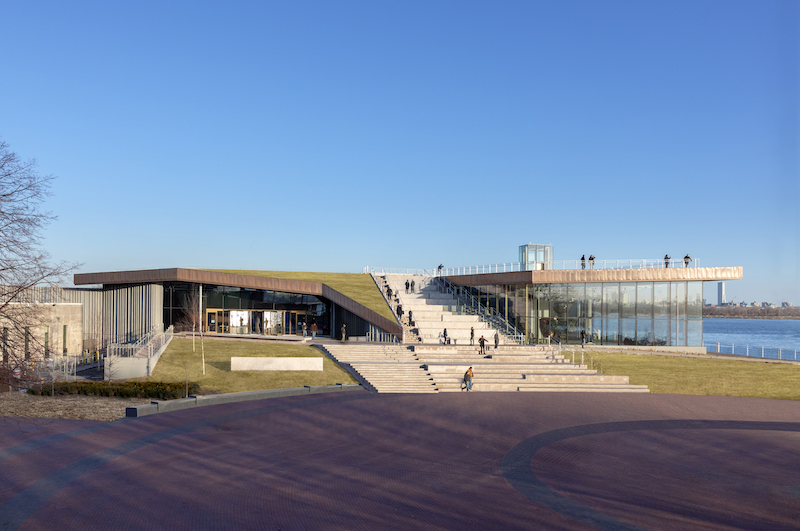A new museum, located on Liberty Island in New York Harbor—with stunning views of the 151-ft-tall Statue of Liberty on the island and the 1,792-ft-tall Freedom Tower in Lower Manhattan—presents visitors with the opportunity to contemplate the changing meaning of liberty in the United States.
Opening officially on Thursday, the 26,000-sf, $70 million Statue of Liberty Museum was designed by FX Collaborative and built by Phelps Construction. The interiors of its three exhibit spaces were created by ESI Design, and include the statue’s original torch, which was relocated from the statue’s base.
The Statue of Liberty-Ellis Island Foundation worked with the National Park Service to create the museum, and provided funding for the building, which had been in the works for about five years, says Daniel Piselli, AIA, LEED AP, CPHD, Director of Sustainability for FX Collaborative. (A time-lapse video of the museum's construction, created by EarthCam, can be viewed here)
Liberty Island attracts 4.3 million visitors annually. A smallish museum that opened within the statue’s pedestal in the 1980s could accommodate only about 20% of its daily traffic. “So one of the goals [for the new museum] was to provide people with more access to the statue’s history,” says Nick Hubbard, ESI Design’s content and activity designer.
The artifacts on display include sculptor Frédéric Auguste Bartholdi’s model for the statue; other working models in plaster, wood, and copper (300 plates of which were used to construct the statue); and lottery tickets sold in France to pay for the statue, a gift from that country to the U.S. (shipped in 350 pieces inside 214 crates) that was dedicated on October 28, 1886.
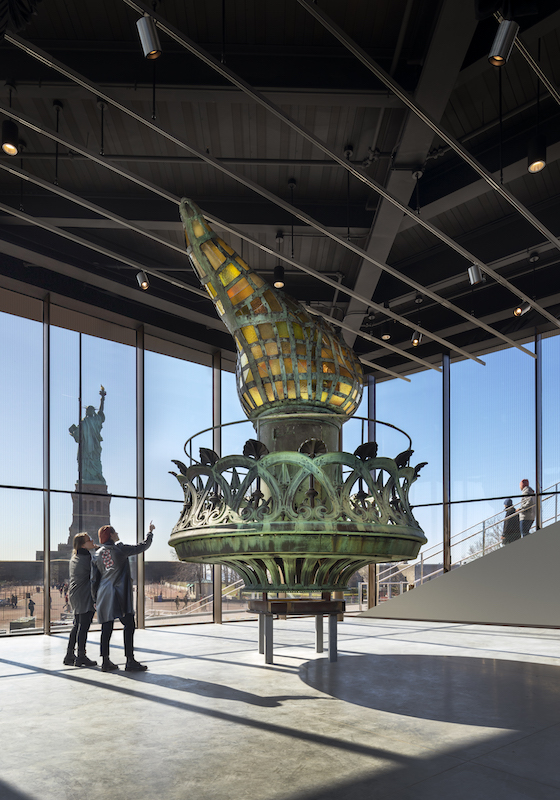
The statue's original torch needed to be disassembled into two pieces in order to move it from the statue's pedestal to the museum's Inspiration Gallery, one of three exhibit spaces. Image: David Sundberg/Esto
The new museum has three exhibit spaces:
•Immersive Theater, in three sections, each 1,000 sf. The first and third sections are 13 ft high, the second 20 ft high. The theaters include massive curved screens with high-def (8K-resolution) projection. The first section focuses on the past, with archival photos and graphics. The second on the construction, with newer footage that includes drone-captured imagery. And the third on the future of the statue and the island, which includes a scheduled beautification program.
•The Engagement Gallery (where most of the artifacts reside).
•The Inspiration Gallery, which is where the original torch now rests. In order to relocate the torch, it had to be disassembled into two pieces and trucked over from the statue’s pedestal.
Hubbard says that ESI “always tries to start with a core narrative that’s site-specific.” In the museum’s case, the metaphor that drives the exhibits is the changing meaning of liberty.
An interactive sketchbook shows Bartholdi’s original drawings for the statue. Visitors to the Inspiration Gallery can document their visit by taking selfies of themselves and merging those shots with different “liberty” images that are then combined and projected onto a 40-ft LED screen “that creates a mosaic,” says Hubbard, and is constantly changing.
The anticipated stay per visitor inside the museum is about 45 minutes. The exhibits are nonlinear, so visitors and start and stop wherever they want. Given that at least half of the island’s visitors are from other countries and might not speak English, ESI made the exhibits even more visual than it normally would. The exhibits include touch models of the statue’s face and foot. “There are all kinds of ways for people to engage the museum,” says Hubbard.
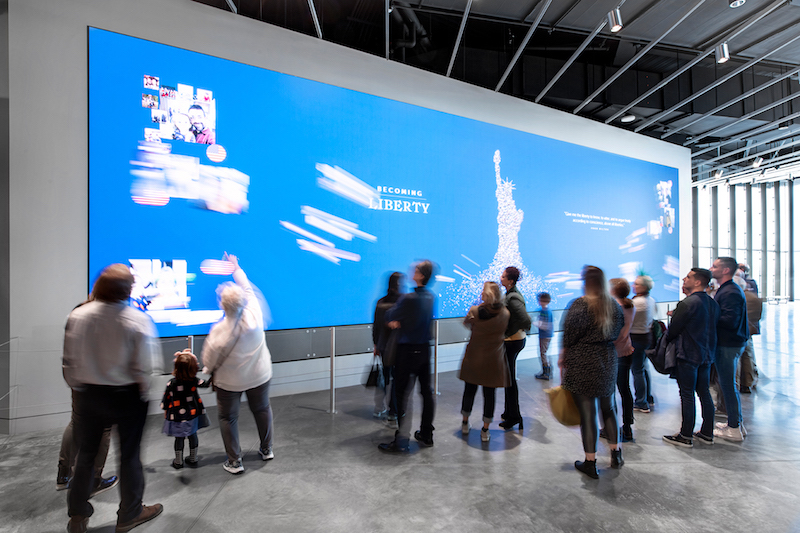
Visitors can take selfies of themselves and marry those images to different symbols or icons of “liberty” that thenn get projected onto a giant screen that creates a mosaic. Image: Keena Photo
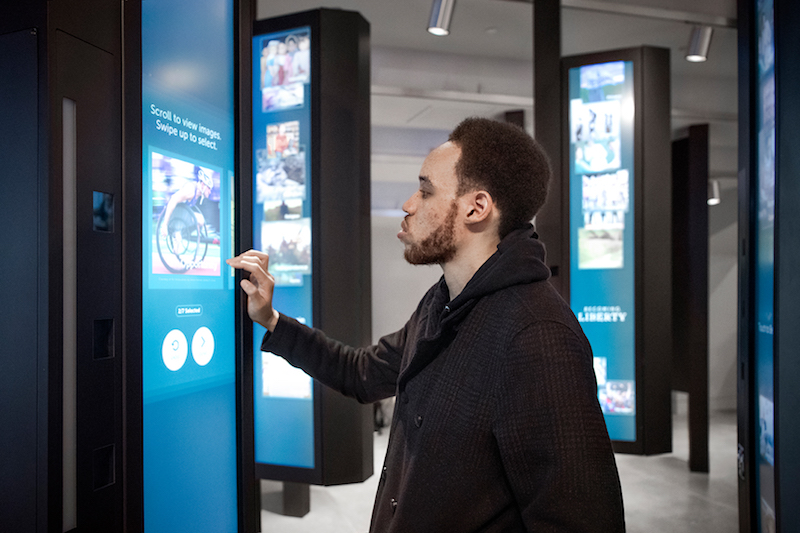
The museum is replete with interactive displays that allow visitors to engage in the statue's history. Image: Keena Photo
Dealing with a tight jobsite surrounded by water
The museum is located at the island’s north tip, on land that once was used for housing (before the September 2001 terrorist attack on the World Trade Center, the park’s superintendent lived on the island), and a Coast Guard barracks that was damaged during Superstorm Sandy in October 2012 and subsequently demolished.
“This project had more logistical issues than any I’ve been involved with previously,” says Doug Phelps, CEO of Phelps Construction, which was hired at the project’s preconstruction phase. The museum’s first floor (which is open, non-usable space) is elevated 10 feet above the island’s 500-year floodplain, and its precast walls have openings that allow sea water in and out.
Phelps says that the only cargo service to Liberty Island had been from the borough of Staten Island. On top of that, the Building Team was instructed that construction could not disrupt the park’s tourism. “We had a very small laydown area, so we had to build a temporary dock,” says Phelps. The construction favored precast concrete panels for the museum’s walls, and a lot of that concrete was poured offsite in Jersey City, N.J., where Phelps Construction had set up a barge. (At one point, Phelps recalls, there were 16 concrete mixers on the barge.)
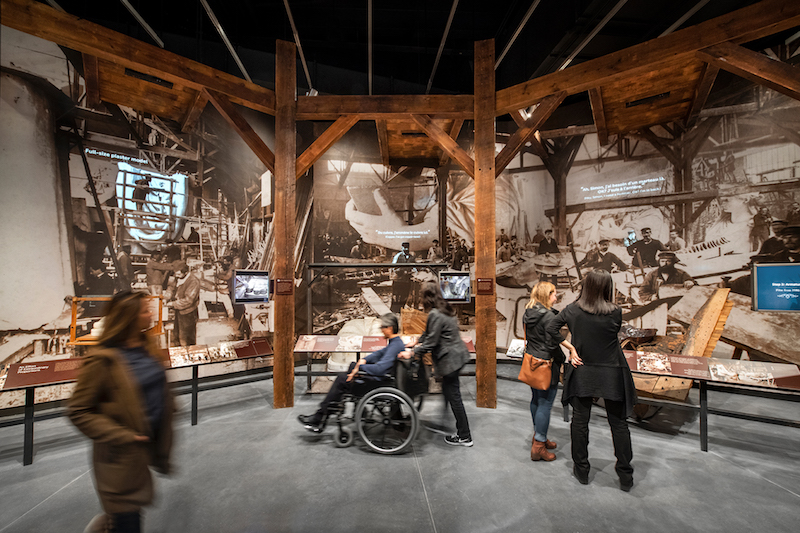
Murals inside of the museum recreate the workshops in France where the statue was built. Image: Keena Photo
“The barging was a big undertaking,” says Phelps. “I know more about tides than I ever thought I would.”
Piselli of FX Collaborative adds that multiple materials were used to mitigate thermal breaks, such as fiberglass for penetrations on the roofdeck, and structural thermal breaks between the interior and exterior concrete slabs.
Because the job site took up a relatively small portion of Liberty Island’s 14.7 acres, the Building Team was limited in how much equipment it could use. “We had one forklift, one crane, and so forth, that everyone had to share,” says Phelps.
The site also had limited availability of underground utilities. Phelps explains that as the island has been expanded by fill over the years, previous construction and engineering teams just left the old seawalls up. So it took a lot of work on the part of the project’s structural engineer, DeSimone Consulting Engineers, to build new footings; Phelps says that something like 150 piles were driven into the site.
The National Parks Service mandates that all of its new buildings must achieve at least LEED Silver certification. The Statue of Liberty Museum was built to achieve LEED Gold. The Service also mandates that its buildings take into account bird migration. So fritt patterns are etched into the museum’s curtainwall to prevent aviary collisions.
Other energy- and water-saving features include the museum’s high-performance envelope and lighting, radiant heating, climate-controlled vitrines to reduce the building’s conditioning load, and its recycling and composting programs.
The museum’s water savings will be 43% over EPA’s baseline, and its energy savings 31% over ASHRAE 90.1 2007 levels. Ninety-two percent of the project’s construction waste was recycled of salvaged.
Piselli says that the integration of landscaping was part of the museum’s design “from the beginning,” and includes stormwater raingardens at grade, and a 14,000-sf green roof with sheltered earth and restored habitat native plantings. FX Collaborative designed the green roof in collaboration with Quennell Rothchild & Partners, which researched native plants and created four seed mixes for different plant areas for the roof, at-grade meadow, shaded meadow, and the 1,000-sf raingarden. The heights of plants and trees were considered to preserve the museum’s views.
Piselli notes that the entire museum’s design “considered the adjacencies to the Statue of Liberty” and site lines to Ellis Island and to Lower Manhattan.
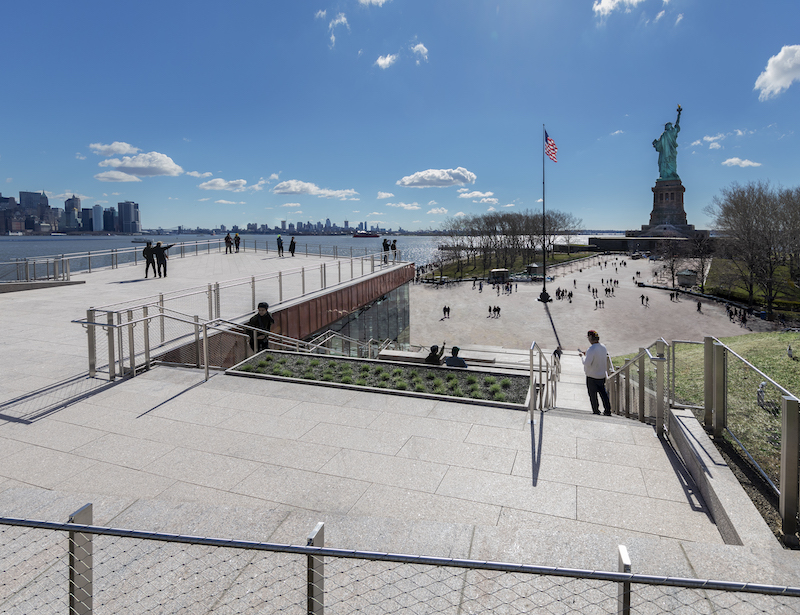
The site lines to the statue, Ellis Island, and Lower Manhattan were important considerations in the design of the new museum, with sits on the northern tip of Liberty Island. The building's roof deck includes a 14,000-sf green roof. Image: David Sundberg/Esto
Related Stories
| Aug 11, 2010
Jacobs, HDR top BD+C's ranking of the nation's 100 largest institutional building design firms
A ranking of the Top 100 Institutional Design Firms based on Building Design+Construction's 2009 Giants 300 survey. For more Giants 300 rankings, visit http://www.BDCnetwork.com/Giants
Museums | Aug 11, 2010
Design guidelines for museums, archives, and art storage facilities
This column diagnoses the three most common moisture challenges with museums, archives, and art storage facilities and provides design guidance on how to avoid them.
| Aug 11, 2010
Museum celebrates African-American heritage
The Harvey B. Gantt Center for African-American Arts + Culture recently completed construction on the Wells Fargo Cultural Campus in Charlotte, N.C. Designed by the Freelon Group, Durham, N.C., with Batson-Cook's Atlanta office as project manager, the $18.8 million project achieved nearly 100% minority participation.
| Aug 11, 2010
Design for Miami Art Museum triples gallery space
Herzog & de Meuron has completed design development for the Miami Art Museum’s new complex, which will anchor the city’s 29-acre Museum Park, overlooking Biscayne Bay. At 120,000 sf with 32,000 sf of gallery space, the three-story museum will be three times larger than the current facility.
| Aug 11, 2010
Thom Mayne unveils ‘floating cube’ design for the Perot Museum of Nature and Science
Calling it a “living educational tool featuring architecture inspired by nature and science,” Pritzker Prize Laureate Thom Mayne unveiled the schematic designs and building model for the Perot Museum of Nature & Science at Victory Park in Dallas. The $185 million, 180,000-sf structure is 170 feet tall—equivalent to approximately 14 stories—and is conceived as a large...
| Aug 11, 2010
Piano's 'Flying Carpet'
Italian architect Renzo Piano refers to his $294 million, 264,000-sf Modern Wing of the Art Institute of Chicago as a “temple of light.” That's all well and good, but how did Piano and the engineers from London-based Arup create an almost entirely naturally lit interior while still protecting the priceless works of art in the Institute's third-floor galleries from dangerous ultravio...
| Aug 11, 2010
The Art of Reconstruction
The Old Patent Office Building in Washington, D.C., completed in 1867, houses two Smithsonian Institution museums—the National Portrait Gallery and the American Art Museum. Collections include portraits of all U.S. presidents, along with paintings, sculptures, prints, and drawings of numerous historic figures from American history, and the works of more than 7,000 American artists.
| Aug 11, 2010
Silver Award: Please Touch Museum at Memorial Hall Philadelphia, Pa.
Built in 1875 to serve as the art gallery for the Centennial International Exhibition in Fairmount Park, Memorial Hall stands as one of the great civic structures in Philadelphia. The neoclassical building, designed by Fairmount Park Commission engineer Hermann J. Schwarzmann, was one of the first buildings in America to be designed according to the principles of the Beaux Arts movement.


